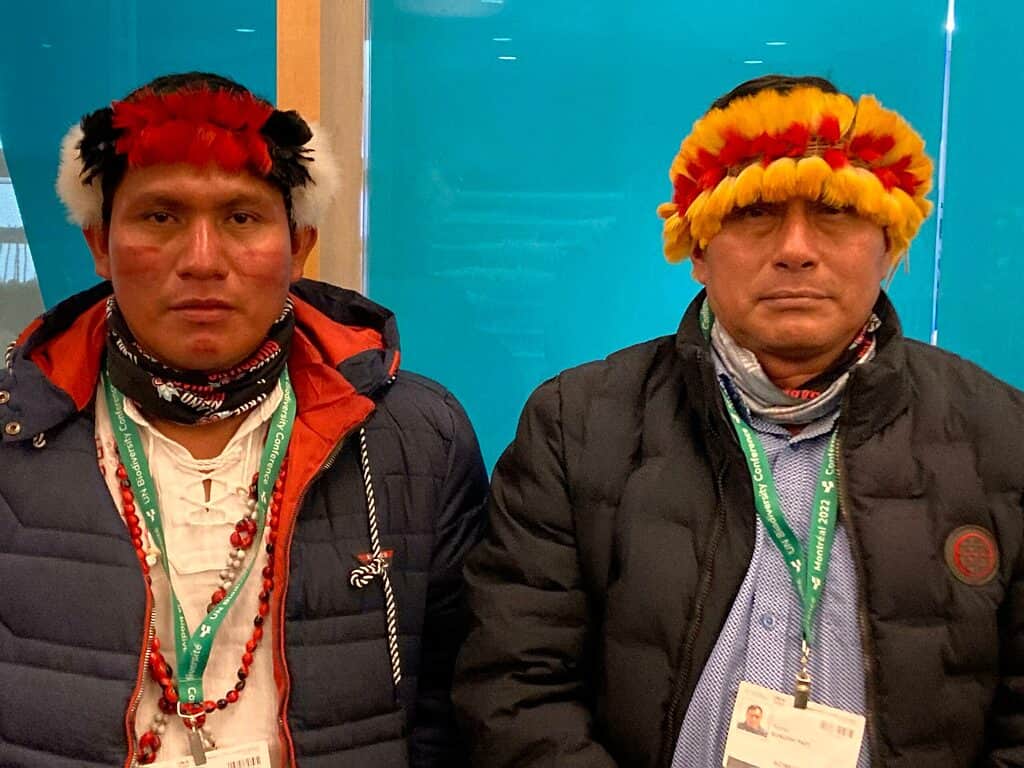Raids from miners, loggers, and companies looking for fossil fuels have left the Wampis indigenous community in the Amazon concerned about their future and the future of their land. They realized that they would only be able to protect their people and livelihoods if they developed their own government structure, which they did back in 2005. They now want to share their story with the world.

An autonomous community in Peru
The Wampis Nation, as they call themselves, is a community of around 16,000 people living in northern Peru along the border with Ecuador. They manage a territory of over 1.3 million hectares of rainforest, where the only routes for accessing trade and contact with the outside world are two big waterways: the Santiago and Morona rivers.
Representatives from the Wampis Nation are now participating in the United Nations biodiversity conference, or COP15, in Montreal, Canada where governments are negotiating a global agreement to protect biodiversity. They argue that any kind of agreement should consider the role of indigenous communities as safekeepers of biodiversity.
“We are the ones who should decide on what goes on in our territories. Instead, governments want to decide for us,” Teofilo Kukush Pati, a representative from the Wampis Nation, told ZME Science. “We’ve been living in the same place for 7,000 years. Our ancestors had their own government system, without the role of the state.”
The territory of the Wampis is fully covered by tropical forest, except for some small agricultural plots and settlement areas. It’s one of the few remaining regions that have full and undistributed connectivity between the Amazon plains and the higher altitude humid forests — therefore having very diverse flora and fauna in their territory.
However, over the last decade, their territory has been increasingly under the attention of private companies wanting to extract natural resources without the Wampis’ consent. In 2009, the situation escalated when the Wampis took to the streets to protest against outsiders violating their lands, amid national laws that encouraged extractive industries.
“The state doesn’t want to recognize our autonomy and continues to negotiate with mining and oil companies in our land. This has led to oil spills that have polluted our rivers,” Teofilo Kukush Pati said. “We have always protected the biodiversity of our land and we want to continue doing the same. 97% of our land is completely intact.”
After declaring themselves autonomous in 2005, the Wampis created a statute that lays out their vision for the future in all areas of life, from religion to education. The statute is built on the obligations of the Peruvian state to respect the rights and autonomy of the Wampis, who should always be asked about activities on their land.
This also means that the government of Peru can’t give any further concessions that allow oil or mining companies to enter Wampis territories without a consultation process. But this isn’t what’s happening, says, Teofilo Kukush Pati said. The government is still not recognizing their autonomous declaration and deciding over their land without them.
The most recent example has been the attempts of Petroperú, the Peruvian state oil company, to exploit an oil area known as Block 64 in the territory of the Wampis. The area has long attracted the interest of companies. But sooner or later, they came up against the rejection of the Wampis and other communities that live in the same area.
Indigenous stewardship of biodiversity
Recent research has shown that indigenous stewardship is linked to biodiversity, and including indigenous populations into decisions about their land tends to boost conservation. But in the vast majority of cases, this approach is still largely ignored by decision-makers.
The biodiversity agreement currently being negotiated includes a proposal to conserve 30% of Earth’s land and sea areas by 2030 through “area-based conservation measures” such as protected national parks. But indigenous communities question the plan, saying it could lead to millions of people being evicted from their ancestral lands.
More than 300 million people live in unprotected “key biodiversity areas,” which cover about 9% of the planet, according to a study last year. Setting up protected areas there would not only be a massive abuse of human rights but also a financial mess, the study found, as many communities would have to be compensated and resettled.
But there’s another and better way forward, indigenous communities argue: Giving power to indigenous communities and helping them get formal land tenure. A study this year by the UN showed deforestation rates were much lower in areas where indigenous communities’ land rights had been formally recognized.
Negotiations over the biodiversity agreement will continue during this week, with the expectation of wrapping up by Friday. However, many differences still remain, especially between developed and developing countries. It will be crucial not only to seal the deal but also for the agreement to be comprehensive, including the voices of indigenous communities.


